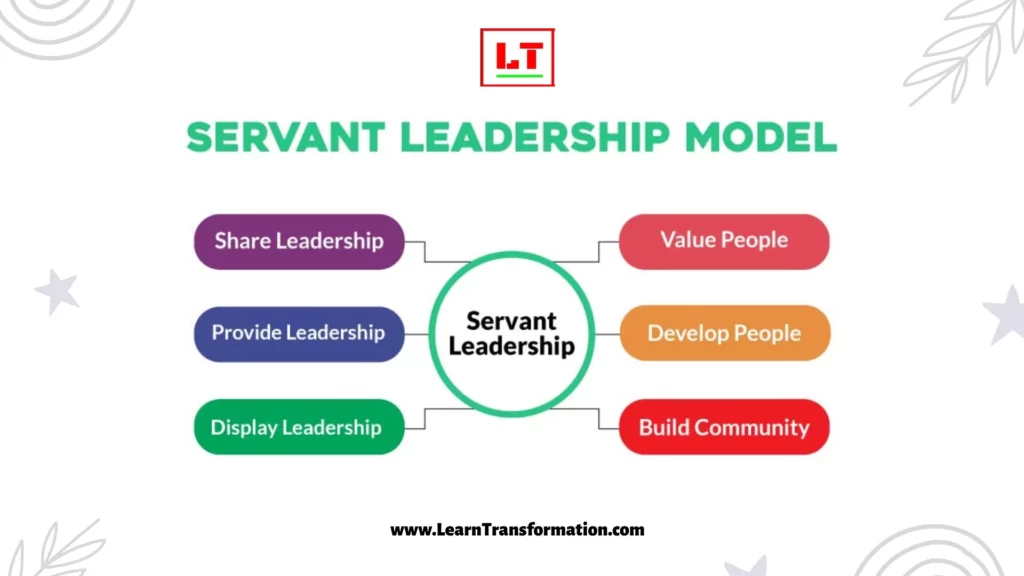Servant leadership is all about making the goals clear and then rolling your sleeves up and doing whatever it takes to help people win. In that situation, they don’t work for you; you work for them.
Servant leadership is a leadership philosophy and practice that emphasizes the role of the leader as a servant of a team or organization. However, It is about putting the needs of others first, fostering their personal growth and development and enabling them to reach their full potential. Also, Servant leaders actively listen, empathize and support their followers with the goal of creating a positive and empowering work environment. It’s goal is to serve others and promote well-being so ultimately leading to higher levels of performance, collaboration and organizational success.
- What is Servant leadership?
- Who is a Servant Leader?
- What are 5 Examples of Great Servant Leader?
- What is Servant Leadership Style?
- What is Servant Leadership Theory?
- About Servant leadership model
- What is the Difference b/w Servant and transformational leadership?
- What is the Principle of Servant leadership?
- Know 5 Servant Leader Qualities
- What are 5 Servant Leadership Examples?
- What are 5 Advantages & Disadvantages of Servant Leadership?
- Best Servant Leadership books
What is Servant leadership?
The phrase was devised by Robert K. Greenleaf in 1970. In this type of leadership, the basic idea is to serve others irrespective of rewards. Thus, Here others may include customers, partners, followers, Co-workers etc.
Who is a Servant Leader?
Robert Greenleaf recognized that organizations, as well as individuals, can be servant-leaders. The servant-leader is a servant first and then a leader. His role is to manage the group’s resources and to teach other leaders to serve others while still accomplishing the goals set forth by the business.
Read Also – Decision Making and Problem Solving is Essential Skill for Every Leader
Leader’s Tip:
We foster a culture of trust and collaboration, encourage open communication, and respect diverse perspectives.
What are 5 Examples of Great Servant Leader?
Thus, Some of the most well-known inspirational leaders are-
1.Kim Savage – The Executive Director for Hope International, has lived her life following the it’s philosophy.
2.Cheryl Bachelder – was named CEO of Popeye’s Louisiana Kitchen; she worked to create a Servant leadership culture at Popeyes as a means to inverse the company’s fortunes.
3.Mahatma Gandhi – A nationalist dedicated his life to serving other people.
4.Martin Luther King, Jr.- left a lasting legacy through his humble and serving nature.
5.Mother Teresa – devoted her life to serving other people.
Read Also: Servant Leadership: The Best Playbook for all Leaders (2024)
What is Servant Leadership Style?
This style is a management style in which one prioritize team’s needs over their own needs. Servant leaders think that when their employees are personally and professionally fulfilled, they are more productive and efficient. So, in it, employee happiness and collaboration are critical themes.
What is Servant Leadership Theory?
Furthermore, As per leadership theory, Leader should emphasize their team members to become self-sufficient and independent thinkers. It is an attitude that puts the needs of others first rather than the needs of the Leader.
Read Also – Best Communication Skills to be a Good Leader
About Servant leadership model
In servant leadership contexts, the authority figure tries to stimulate creativity, empower people, and ensure the well-being of those around them and by moving management and personnel contact away from regulating activities and toward a synergistic partnership.

What is the Difference b/w Servant and transformational leadership?
- In Servant leadership, the main focus is on goals, whereas the main focus is on serving people in transformational leadership.
- In it, leaders Influence through their service, whereas through their charisma, in transformational leadership.
- It comprises a broader cause or greater good, such as community development or pollution reduction. Transformational leadership, on the other hand, attempts to at improving organizations and people in a broader sense, i.e., companies, organizations, and teams.
Read Also: What Is Servant Leadership – Characteristics, Theory, And Examples
What is the Principle of Servant leadership?
So, Principles of servant leadership are listening, healing; awareness; persuasion; conceptualization; foresight; empathy; stewardship; commitment to people’s growth, and building community.
Know 5 Servant Leader Qualities
Thus, Here are some qualities of a Servant leader-
- Empathy
- Humility
- Self- awareness
- Persuasive
- Stewardship
Read Also: 5 Secrets To Successfully Switch Career Paths
Leader’s Tip:
Lead by example and show humility, empathy, and a willingness to serve others.
What are 5 Servant Leadership Examples?
Thus, Here are some examples
- By putting other people’s needs first, Martin Luther King, Jr. was able to leave a lasting legacy, which evidences that anyone can make a difference through a humble and serving perspective.
- Nelson Mandela said he was a humble servant with a passion for his people and the desire to see them enjoy equality.
- Mother Teresa devoted her life to serving other people.
- Kim Savage lived her life following the it philosophy.
- Popeye’s Louisiana Kitchen CEO, Cheryl Bachelder worked to create it culture to inverse the company’s fortunes.
What are 5 Advantages & Disadvantages of Servant Leadership?
So, Advantages are-
- Greater organizational agility
- Provides a positive work environment
- Employees feel valued
- It is hard to fake
- It Inculcates values.
So, Disadvantages are-
- Decision-making is slower
- It takes real effort to set it up
- Some may perceive Servant leaders as ineffective
- Different leadership styles across teams can lead to confusion
- It can be more time-consuming
Best Servant Leadership books
Thus, Here are some books –
- Servant Leadership: A Journey into the Nature of Legitimate Power and Greatness by Robert K. Greenleaf
- The Power of Servant Leadership by Robert K. Greenleaf
- The Journey to the East by Hermann Hesse
- Dare to Serve by Cheryl Bachelder
- The Serving Leader by Kenneth R. Jennings and John Stahl-Wert
- The Servant Leader by James A. Autry
Frequently Asked Questions (FAQs):
Should you become a Servant Leader? Is Servant leadership style the Right Choice?
Do you want to turn out to be a Servant Leader? So here are some benefits of it’s for you-
- It boosts morale
- Accelerates learning
- Provides a positive work environment.
What are 5 Ways to become Servant Leader?
A good servant leader should inculcate the following things-
- Teamwork
- Adaptability
- Authenticity
- Mentor, respect and encourage employees
- Stand out from the pack.
Key Takeaways:
- Servant leadership is a powerful approach focused on the growth and success of others.
- It requires selflessness, empathy, and a commitment to actively support and grow the people you lead.
- By prioritizing the needs of others, service leaders create a positive and empowering work environment.

